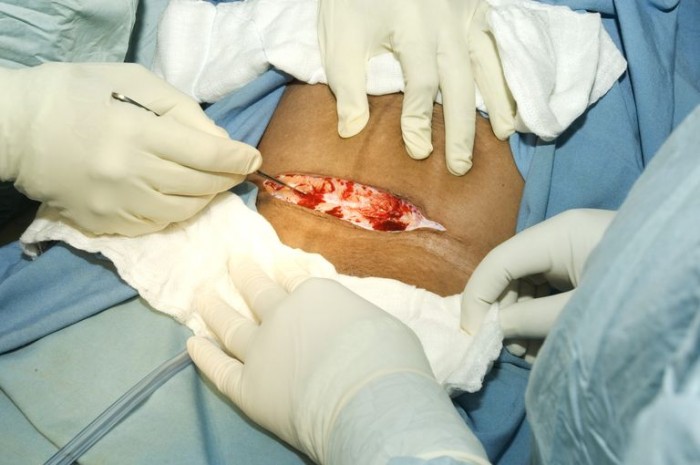The cesarean section surgery rate is about a third of all births in countries like the US. The decision to have a cesarean can arise before labor, often called a planned or scheduled cesarean. Common reasons to schedule a cesarean before labor may include a breech presentation, a previous cesarean where vaginal birth after cesarean (VBAC) is not advised or desired, placenta previa, etc. The decision might also happen in labor.
This might be because it is thought that labor is taking too long, mother or baby is not tolerating labor well, or other issues arise, like it is found that the baby is in a malposition. This is typically called an unplanned cesarean. In a few cases, it will be a true emergency, like in the case of a placental abruption, severe bleeding, etc.
To all mamas and mamas to be…..here is a picture essay, step by step of a c-section birth.
To prepare for the operation, an IV will be placed in a woman’s arm or hand to give fluids and medications needed during surgery.
Her abdomen will be washed and her pubic hair may be clipped or trimmed. A catheter is placed into a woman’s bladder to remove urine, and it will stay for a day after the surgery.
After you have received your anesthesia, usually a spinalorepidural and all that entails, you will be ready for surgery. The anesthesia can take a bit to accomplish, sometimes 20-30 minutes. The powerful numbing will happen quickly and effectively.
Women are usually given regional anesthesia, either an epidural block or a spinal block. Both numb the lower half of the body but will allow the mother to be awake when her baby is born.
This tends to be safer than general anesthesia, where a woman would be totally asleep during the delivery, Bryant said.
While you are receiving your anesthesia, the room will be quite busy as the other nurses and doctors are preparing the room with instruments, and preparing the warmer for the baby.
In this photo you will see that the mother has been draped with sterile drapes and is in the operating room as they make the initial incision into her abdomen.
There are multiple layers that your surgeon must go through before reaching the baby. All in all from the start of surgery, until the birth of your baby is about 5-10 minutes.
The doctor will use a combination of sharp instruments and blunt dissection as she/he goes through each layer. You may also hear whirring noises as a machine is used to cauterize or burn small blood vessels to prevent bleeding. Sometimes there are strange smells.
When the doctor reaches the uterus, you will also hear suctioning. After cutting through the uterus, the amniotic fluid will be suctioned away to make a bit more room in the uterus for the doctor’s hands or instruments such as forceps or a vacuum extractor.
Your baby is usually engaged in the pelvis, usually head down, but perhaps rear first or breech.
Whatever part has entered the pelvis will be lifted out by the doctors. You may feel pressure at this point and some women report feeling nauseated during this intense, but brief moment.
The baby’s head is born. Once the head is out, your doctor will suction the baby’s nose and mouth for fluids. In a vaginal birth, these are normally squeezed out by the process labor and birth.
In a cesarean birth, the baby needs some extra help getting rid of these fluids. If meconium is present, there may be extra suctioning required.
The surgeon will need to maneuver the baby back and forth to help them be born. You may feel this wiggling.
Once your baby has been well suctioned, the doctor will start to help the rest of the body be born. She/he will check for umbilical cord entanglement or other complications as the body is born.
The umbilical cord is cut, and the placenta is removed.
You may also have the assistant surgeon pressing on the upper part of your abdomen of fundus to assist in the birth.
The baby is born….
The moment you’ve been waiting for, your baby’s birth. It’s been about 5-10 minutes since your surgery started.
Your baby will typically be briefly held over the drape to show you the baby and then taken away by a nursery nurse or neonatologist to a nearby warmer depending on the set up of the operating room.
With some prior planning, you can request to be skin-to-skin with your baby immediately, while they finish the surgery. If your baby goes to the warmer, it is usually in the same room as the surgery.
Here your baby will be suctioned again to ensure that they have help clearing the amniotic fluid.
Your baby may also have some basic care like weighing, measuring, vitamin K, etc. The repair of the uterus and the layers that were cut during the surgery need to be completed before the end of the surgery.
During this portion of the surgery the placenta will also be removed and examined by your doctor. This is the longest part of the cesarean section, which total takes about 45-60 minutes to complete.
During this time you can usually have your baby with you to breastfeed or hold. It can also be possible for your support person to hold the baby close to your face if you are unable to hold your baby.
After everything is finished surgically, your surgeon will suture (sew) or staple your incision shut.
It will be covered with a bandage. You will be watched in the post-op area for at least an hour to ensure that your vital signs are stable and that you aren’t bleeding too heavily, though everyone will bleed vaginally from the healing uterus. You will then be taken to your postpartum room.
There you will spend the remainder of your stay, which is usually four days.
A year after a csection.
How to get back in shape after a csection (Read the article here: https://m.wikihow.com/Exercise-After-a-C-Section)




